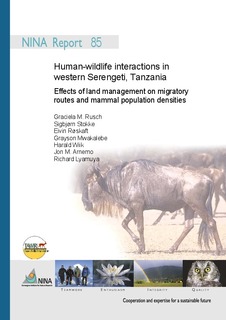| dc.description.abstract | The Serengeti-Mara ecosystem constitutes one of the last great migratory systems in Africa and supports the highest concentrations of large predators in the world. The health of the ecosystem, as judged by fundamental processes has been regarded as good, however, the prospects for the future maintenance of its integrity need to consider the enormous expansion of human activities in the region as well as the current global notion that protected areas cannot be managed in isolation from the local claims of poverty alleviation and rural development. Consequently, a better understanding of the interactions between land management and wildlife biodiversity is critical to face current challenges of protected area management. In this study, we focused on three issues aiming to gain knowledge on land management – wildlife interactions. First, we documented the distribution patterns of all larger mammal species along ground transects stretching from the protected area into the open land (in our case, the communal land in the non-protected area) on a monthly basis and during a period of 3 years. Second, we assessed the patterns of migratory behaviour of Serengeti wildebeest (Connochaetes taurinus) using modern telemetry, which yielded the most complete and accurate data set to date. Thirdly, we established the distribution and quality of forage in terms of the biomass of herbaceous vegetation in three land-management areas and assessed consumption during the migration period to link forage availability to the use of the area by herbivores. Our results on wildebeest movements agree generally with earlier notions that the migration in Serengeti occurs mostly within the protected area. However, the transect records showed that large herds of wildebeests use non-protected areas while migrating north which reveals that there are at present important areas of the ecosystem, as defined by the migrants that are not protected. Our data also indicate important differences in the northward migration route compared to the one described earlier in the late seventies, when the migration made an extensive use of the western corridor area. In contrast, our data suggest a more eastern route, following a narrow fringe along the borderline between the national nark and the game reserve areas. Both the wildebeest distribution maps and the daily movement distances indicate that in the dry season, the wildebeest made a more concentrated use of the range compared to the rain season period. This pattern can be attributed to relatively higher forage availability (higher standing biomass) in the dry season range compared to that in the plains in the rain season. Other possible causes can be the availability of fewer water sources in this season that force the animals to concentrate the use in their vicinity or the impact of agricultural activities that have greatly expanded in the Mara area in the last decades. Mammal densities, GPS-telemetry, ground transects, DISTANCE, biomass assessments, fire, Pattedyrtetthet, GPS-teknologi, bakketransekter, DISTANCE, biomasseestimering, brann | nb_NO |
